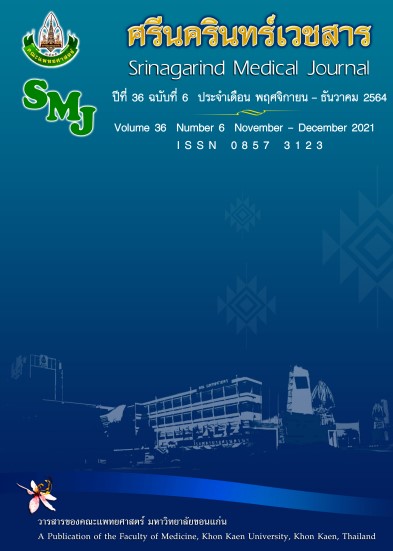Conventional Pap Smear for Detecting High-grade or Recurrent Lesion in the Follow-up After Treatment of Cervical Cancer
Keywords:
Keywords: Cervical Cancer; Papanicolaou Smear; Local RecurrenceAbstract
วัตถุประสงค์: เพื่อประเมินโอกาสตรวจพบรอยโรคขั้นสูง(cervical intraepithelial neoplasia (CIN) 2,3 หรือ vaginal intraepithelial neoplasia (VAIN) 2,3) หรือมะเร็งกลับเป็นซ้ำเฉพาะที่ในผู้ป่วยมะเร็งปากมดลูกภายหลังรักษาที่มีผล conventional Pap smear ผิดปกติ
วิธีการศึกษา: ศึกษาแบบ screening test research รูปแบบ retrospective descriptive diagnostic test study เก็บข้อมูลจากเวชระเบียนในผู้ป่วยมะเร็งปากมดลูกภายหลังรักษาที่มีผล conventional Pap smear ผิดปกติ 115 ราย ที่ได้รับการตรวจปากมดลูกด้วยกล้องขยายทางช่องคลอด(colposcopy) 149 ครั้ง ที่โรงพยาบาลมหาราชนครราชสีมา ระหว่างวันที่ 1 ตุลาคม พ.ศ. 2555 ถึง 30 กันยายน พ.ศ. 2562
ผลการศึกษา: ตรวจพบรอยโรคขั้นสูงหรือมะเร็งกลับเป็นซ้ำเฉพาะที่ 54 ครั้งของการตรวจปากมดลูกด้วยกล้องขยายทางช่องคลอด (ร้อยละ 36.2) โดยพบมะเร็งกลับเป็นซ้ำเฉพาะที่ 28 ครั้ง (ร้อยละ 18.8) กลุ่ม High grade smear มีโอกาสตรวจพบรอยโรคขั้นสูงหรือมะเร็งกลับเป็นซ้ำเฉพาะที่มากกว่ากลุ่ม Low grade smear 3.19 เท่า โดยมี PPV ร้อยละ 49.5 (95% CI 38.8-60.1) และร้อยละ 15.5 (95% CI 7.3-27.4) ในกลุ่ม High grade smear และ Low grade smear ตามลำดับในกลุ่ม Low grade smear 2 ใน 3 รายที่พบมะเร็งกลับเป็นซ้ำเฉพาะที่ มีการติดเชื้อ Human immunodeficiency virus (HIV) ร่วมด้วย โดยมี PPV ของการตรวจพบมะเร็งกลับเป็นซ้ำเฉพาะที่ ร้อยละ 5.2 (95% CI 1.1-14.4)
สรุป: ผู้ป่วยมะเร็งปากมดลูกภายหลังรักษาที่มีผล conventional Pap smear ผิดปกติเป็น High grade smear ควรได้รับการตรวจปากมดลูกด้วยกล้องขยายทางช่องคลอด ส่วน Low grade smear ที่ไม่พบการติดเชื้อ HIV สามารถติดตามการรักษาได้
คำสำคัญ : มะเร็งปากมดลูก; การตรวจแป๊ปเสมียร์; มะเร็งกลับเป็นซ้ำเฉพาะที่
Objective: To evaluate the probability of the detection of high-grade dysplasia (cervical intraepithelial neoplasia (CIN) 2,3 or vaginal intraepithelial neoplasia (VAIN) 2,3) or locally recurrent cancer in treated women for cervical cancer with abnormal conventional Pap smear
Method: A screening test research, retrospective descriptive diagnostic test study, by reviewing medical records of 115 cervical cancer patients with abnormal conventional Pap smear through 149 colposcopic examinations at Maharat Nakhonratchasima hospital from October 1, 2012 to September 30, 2019.
Results: Fifty-four (36.2%) of colposcopic examinations revealed high-grade dysplasia or locally recurrent cancer. Twenty-eight (18.8%) were locally recurrent cancer. High grade smear patients had a higher risk to detect high-grade dysplasia or locally recurrent cancer than Low grade smear patients (Risk ratio: 3.19). The results led to 49.5% (95% CI 38.8-60.1) and 15.5% (95% CI 7.3-27.4) of positive predictive value (PPV) in High grade smear and Low grade smear, respectively. 2 of 3 locally recurrent cancer-detected patients in Low grade smear also had a Human immunodeficiency virus (HIV) infection, with 5.2% (95% CI 1.1-14.4) of PPV in locally recurrent cancer detection.
Conclusion: Cervical cancer patients with High grade smear on conventional Pap smear should undergo immediate colposcopic examination, while HIV-uninfected patients with Low grade smear (ASC-US, LSIL) can be followed without colposcopy.




